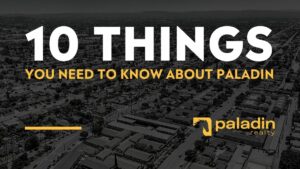December 4, 2023
Let the games begin
With $15 billion of apartment loans maturing in Southern California over the next few years (one in five loans) and interest rates 500 bp higher than a year ago, the Federal Reserve will be giving savvy real estate investors a once-in-a-decade buying opportunity in 2024.
Sign up for our "Paladin Insights" Newsletter for monthly commentary on real estate market trends.
Our investment offerings tend to oversubscribe quickly. So, we encourage you to join our waitlist for new offerings. There is no obligation to invest.
Commercial real estate is facing pressure
The past year has brought challenging times for investors in all asset classes, including real estate. Since early 2022, we’ve seen the steepest and largest increase in U.S. interest rates in more than a generation, greatly impacting net cash flows, transaction volume and pricing of most real estate assets. While headline inflation has come down in recent months, volatile energy costs continue to put pressure on consumer prices. There are signs of labor market cooling and private sector job growth was flat in October. Wars are raging in the Middle East and Europe. In our view, the risk of a U.S. recession in 2024 remains significant.
Against this uncertain economic backdrop are additional pressures uniquely affecting commercial real estate. Office and retail properties continue to grapple with shifting trends in remote work and consumer behavior. Certain Sunbelt and Southern U.S. markets are seeing a 40-year high of new apartment construction being delivered, as supply quickly caught up with demand in these low barrier “growth” markets. Property insurance costs are up 15-20% year over year and many major providers are leaving the market.
Adding further pressure is more than $1 trillion of CRE loans across the U.S. and multiple product types that will be maturing in the next three years. Many of the underlying real estate assets will struggle to extend, restructure or refinance in today’s higher interest rate environment. This will put strain on regional banks and other CRE lenders.
Meanwhile, SoCal apartment fundamentals remain strong…
While not immune to the market stresses described above, Class B/C apartments in Southern California are an attractive defensive play today because they provide an essential need – affordable market-rate workforce housing – to a huge permanent renter class in one of the largest, most dynamic and supply-constrained markets in the U.S. As a result, these properties tend to always stay occupied during good times and bad, providing strong downside protection for conservatively capitalized investors.
Further, because of the preponderance of smaller assets in this market (85% of the existing rental housing stock is 50 units or less), smart investors can avoid auctions and buy from a large, fragmented pool of “mom and pop” owners with little institutional competition. This creates an abundance of value-added opportunities and a competitive edge for institutional-quality operators like Paladin, especially today.
Importantly, these unique advantages are structurally imbedded in the SoCal apartment market. You cannot replicate these characteristics in other U.S. markets or product types.
…which might explain why we haven’t done a new deal lately
As many of you know, we haven’t made a new apartment investment in over a year. Paladin is fortunate to be a financially strong firm with multiple institutional business platforms, so we’ve never faced any pressure to put out capital merely to keep the lights on. Rather, we can afford to be conservative and highly selective – which is very important right now.
Our main challenge this past year to acquire new assets has been a huge bid-ask spread between buyers and sellers, as well as the fact that debt maturities haven’t yet forced many transactions at prices that reflect today’s higher cost of capital.
No one is a seller today unless they absolutely must be. Much of what’s on the market is garbage. Not surprisingly, transaction volume is down about 75% from 2021 levels.
The few apartment assets that are indeed selling are priced at 100 to 150 bp higher cap rates (or more) compared to a year or two ago. This translates into a decline in value of at least 20-25% for most SoCal submarkets from their peak in 2021, generally consistent with what we saw during the 2008-09 Global Financial Crisis.
Still, much of what’s been on the market recently has not been realistically priced and appears to be optimistically awaiting the elusive and price-incentive 1031 buyer.
This will change in 2024
As a result of hiking interest rates more than 500 bp, Powell has created a once-in-a-decade buying opportunity for savvy real estate investors in 2024, especially in SoCal with $15 billion of apartment loans maturing in the next few years.
If forced to refinance, many borrowers will see their cash flow after debt service drop to zero or into negative territory and decide to throw in the towel. Others will be forced to find costly “rescue capital” to fund a refinancing shortfall caused by lower loan amounts adjusting to higher interest rates. Some assets will be so severely underwater that they will be foreclosed upon by lenders and sold.
This combined effect of higher interest rates and a wave of looming debt maturities will put increased pressure on sellers in 2024 and force greater transaction volume at market clearing prices reflecting today’s cost of capital.
We’re gearing up for what we expect will be an attractive buying opportunity next year for a strategy underpinned more by favorable, structurally imbedded, long-term supply-demand fundamentals, rather than market timing.
If you’d like to join the waitlist for our new offerings, click here (no obligation to invest).
For the latest CRE industry insights, follow Fred Gortner on:
For the latest news and insights from Paladin Realty, follow us on:
For the latest CRE industry insights,
follow Fred Gortner on:
For the latest news and insights from Paladin Realty,
follow us on:



